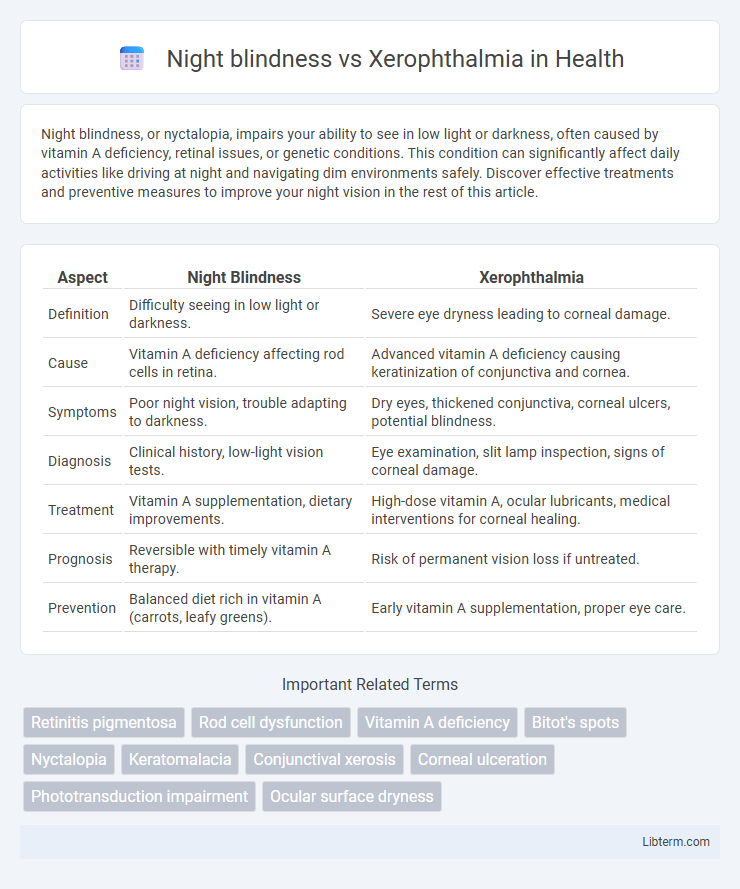Night blindness, or nyctalopia, impairs your ability to see in low light or darkness, often caused by vitamin A deficiency, retinal issues, or genetic conditions. This condition can significantly affect daily activities like driving at night and navigating dim environments safely. Discover effective treatments and preventive measures to improve your night vision in the rest of this article.
Table of Comparison
| Aspect | Night Blindness | Xerophthalmia |
|---|---|---|
| Definition | Difficulty seeing in low light or darkness. | Severe eye dryness leading to corneal damage. |
| Cause | Vitamin A deficiency affecting rod cells in retina. | Advanced vitamin A deficiency causing keratinization of conjunctiva and cornea. |
| Symptoms | Poor night vision, trouble adapting to darkness. | Dry eyes, thickened conjunctiva, corneal ulcers, potential blindness. |
| Diagnosis | Clinical history, low-light vision tests. | Eye examination, slit lamp inspection, signs of corneal damage. |
| Treatment | Vitamin A supplementation, dietary improvements. | High-dose vitamin A, ocular lubricants, medical interventions for corneal healing. |
| Prognosis | Reversible with timely vitamin A therapy. | Risk of permanent vision loss if untreated. |
| Prevention | Balanced diet rich in vitamin A (carrots, leafy greens). | Early vitamin A supplementation, proper eye care. |
Understanding Night Blindness
Night blindness, or nyctalopia, is characterized by difficulty seeing in low light or darkness due to impaired rod cell function in the retina, often linked to vitamin A deficiency or retinal diseases. Xerophthalmia refers to a severe vitamin A deficiency condition leading to dryness and damage of the conjunctiva and cornea, which can progress to night blindness as an early symptom. Understanding night blindness involves recognizing its impact on rod photoreceptors and the critical role of vitamin A in maintaining retinal health and proper vision in dim environments.
What is Xerophthalmia?
Xerophthalmia is a severe eye condition caused by vitamin A deficiency, characterized by dryness of the conjunctiva and cornea, leading to night blindness and potentially irreversible vision loss. Unlike simple night blindness, xerophthalmia involves structural damage such as conjunctival xerosis, Bitot's spots, and corneal ulceration. Early diagnosis and vitamin A supplementation are critical to prevent progression and permanent blindness.
Key Causes of Night Blindness
Night blindness primarily results from vitamin A deficiency, retinitis pigmentosa, or cataracts affecting the retina's rod cells responsible for vision in low light. Xerophthalmia, a severe form of vitamin A deficiency, leads to dryness and damage of the conjunctiva and cornea but is distinct from night blindness in clinical presentation. Identifying vitamin A deficiency early is crucial to prevent progression from night blindness to xerophthalmia and subsequent irreversible eye damage.
Primary Causes of Xerophthalmia
Night blindness primarily results from vitamin A deficiency affecting rod photoreceptors in the retina, leading to impaired vision in low light. Xerophthalmia, a severe eye condition caused by prolonged vitamin A deficiency, involves dryness and keratinization of the conjunctiva and cornea. Primary causes of xerophthalmia include inadequate dietary intake of vitamin A, malabsorption syndromes, and chronic infections that increase vitamin A demand or reduce its bioavailability.
Symptoms: Night Blindness vs Xerophthalmia
Night blindness primarily presents as difficulty seeing in low-light or darkness, often resulting from vitamin A deficiency affecting rod photoreceptor function in the retina. Xerophthalmia, a more severe condition caused by prolonged vitamin A deficiency, includes symptoms such as dryness of the conjunctiva and cornea, Bitot's spots, and corneal ulceration leading to blindness. While night blindness affects vision adaptation in darkness, xerophthalmia involves progressive ocular surface damage and potential permanent vision loss.
Risk Factors: Who is Vulnerable?
Night blindness primarily affects individuals with vitamin A deficiency, commonly seen in populations with inadequate dietary intake, malabsorption disorders, or chronic illnesses such as liver disease. Xerophthalmia, a severe progression of vitamin A deficiency, poses a higher risk to children under five, pregnant women, and those living in regions with limited access to vitamin A-rich foods. Both conditions are prevalent in low-income countries where malnutrition, infectious diseases, and poor health infrastructure increase vulnerability.
Diagnosis and Clinical Evaluation
Night blindness is diagnosed primarily through patient history and electroretinography, revealing impaired rod cell function under low-light conditions. Xerophthalmia diagnosis involves clinical evaluation of conjunctival and corneal dryness, with slit-lamp examination identifying Bitot's spots and corneal ulcers. Both conditions require assessment of vitamin A levels to differentiate between retinal dysfunction and ocular surface disease.
Treatment Options and Management
Treatment options for night blindness primarily involve addressing underlying vitamin A deficiency through high-dose vitamin A supplements and dietary improvements rich in beta-carotene. Xerophthalmia management requires aggressive vitamin A therapy combined with careful monitoring to prevent corneal ulceration and blindness, often necessitating both systemic and topical interventions like lubricating eye drops. Early diagnosis and consistent vitamin A replenishment are critical to prevent irreversible ocular damage in both conditions.
Prevention Strategies for Both Conditions
Night blindness prevention involves adequate vitamin A intake through foods like liver, carrots, and leafy greens, combined with regular eye check-ups to address early symptoms. Xerophthalmia prevention requires consistent vitamin A supplementation in high-risk populations, improved sanitation to reduce infections, and health education to promote balanced diets rich in vitamin A and fats. Both conditions benefit from community-based nutrition programs and public health policies aimed at reducing vitamin A deficiency worldwide.
Long-term Outlook and Complications
Night blindness primarily results from vitamin A deficiency and can improve with adequate supplementation; however, if untreated, it may progress to xerophthalmia, a more severe condition causing permanent corneal damage and irreversible blindness. Xerophthalmia involves chronic dryness and keratinization of the conjunctiva and cornea, often leading to corneal ulcers, scarring, and vision loss, with long-term complications including blindness and increased susceptibility to eye infections. Early intervention and sustained vitamin A therapy are critical to prevent permanent ocular damage and improve the long-term prognosis of both conditions.
Night blindness Infographic

 libterm.com
libterm.com